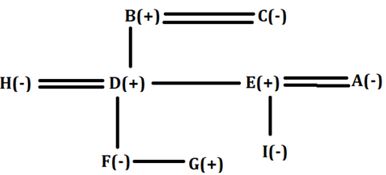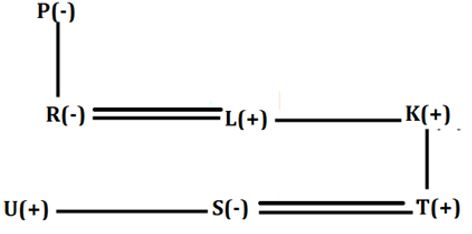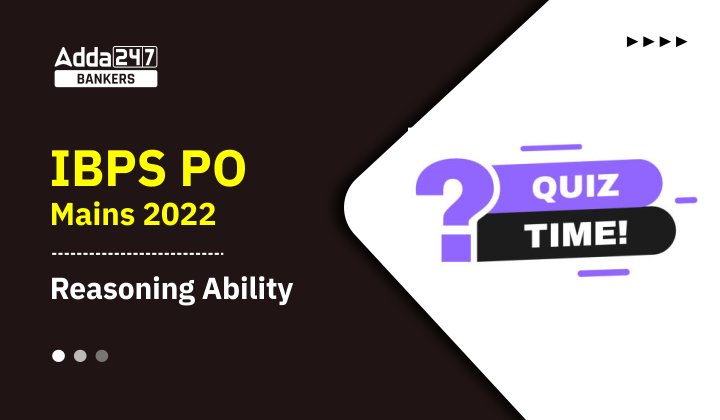Directions (1-2): Answer the questions based on the information given below.
A @ B means A is not smaller than B
A & B means A is neither smaller than nor equal to B
A % B means A is neither greater than nor equal to B
A# B means A is not greater than B
A $ B means A is neither smaller than nor greater than B
Q1. Statements: M % B #R @ Q & S $ N, N % V @ P $ O @ L
Conclusion: I. L%B
II. R & N
(a) Only I is true
(b) Only II is true
(c) Either I or II is true
(d) Neither I nor II is true
(e) Both I and II are true
Q2. Statements: S % A # T & U @ H$ L, P % Q # U $ O & J
Conclusion: I. L & P
II. S% Q
(a) Only I is true
(b) Only II is true
(c) Either I or II is true
(d) Neither I nor II is true
(e) Both I and II are true
Q3. Which of the following combination of alphabets should be placed in the blank sequentially in the given expression in order to make the expressions A > B always true?
___> ____=____≥_____> _____< ____
(a) A, C, D, E, F, B
(b) B, C, D, E, A, F
(c) C, A, D, B, E, F
(d) B, E, F, C, A, D
(e) A, E, F, D, B, C
Q4. Which of the following symbols should replace this question mark in the given expression in order to make the expressions P>Q and Q<R always true respectively?
H < I ≥ J > P ? A ≥ B = Q ≤ O ? R = L
(a) =, ≤
(b) ≥, =
(c) >, <
(d) >, =
(e) <, ≤
Directions (5-6): In the following question the relationship between different elements are given in the statements followed by conclusions. Read the statements carefully and mark your answer accordingly.
Q5. Statements: Q > R ≥ V, V ≤ Y < Z = O, K ≤ L < O = M ≥ N
Conclusions: I. V > M
II. Z > K
III. Q < Z
(a) Only I and II are true
(b) Only II and III are true
(c) Only II is true
(d) Only I and III is true
(e) None is true
Q6. Statements: T ≤ K > Q ≥ M, M < N ≥ S, S > R = P ≥ L
Conclusions: I. N > P
II. S < K
III. R > M
(a) Only I is true
(b) Only II and III are true
(c) Only II is true
(d) Only I and III is true
(e) None is true
Directions (7-9): Read the following information carefully and answer the questions below.
A family consists of nine members. There are more female members than male members. B has two sons. F is the daughter of H and C is the mother of D. G who is the brother of F, is the son of D who is the son of B. B is the grandfather of I who is not a sibling of F. C has a child E who is married to A.
Q7. How is A related to F?
(a) Uncle
(b) Aunt
(c) Brother
(d) Sister
(d) Sister-in-law
Q8. Who is the grandmother of I?
(a) A
(b) D
(c) H
(d) C
(e) None of the above
Q9. How is H related to B?
(a) Daughter-in-law
(b) Son-in-law
(c) Sister-in-law
(d) Brother-in-law
(e) None of the above
Directions (10-12): Answer the questions based on the information given below.
If A @ B means A is Mother of B,
A # B means A is Father of B,
A % B means A is Sister of B,
A & B means A is married to B,
A $ B means A is Brother of B.
Q10. In expression (P@R&L$K#T&S%U), If U is a male member of the family, then, how is T related to P’s daughter?
(a) Son
(b) Son-in-law
(c) Nephew
(d) Niece
(e) None of the above
Q11. In expression (U%S&K@R$M%T#Q$L), how is Q related to M?
(a) Son
(b) Daughter
(c) Nephew
(d) Niece
(e) None of the above
Q12. In expression (U%S&K@R$M%T#Q$L), how is U related to T?
(a) Maternal aunt
(b) Paternal aunt
(c) Sister-in-law
(d) Uncle
(e) None of the above
Directions (13-15): Answer the questions based on the information given below.
Nine persons (P, Q, R, S, T, U, V, W, and X) belong to a family of two generations. U is married to son-in-law of P. X is mother-in-law of R who is a male member. Neither Q nor U is married to R. X has only two daughters and has one brother who is married. V is father of S who is nephew of P. X, Q and T are of same gender. S has no sibling. Q is not younger to T.
Q13. How is Q related to T’s mother?
(a) Brother
(b) Sister
(c) Sister-in-law
(d) Brother-in-law
(e) None of the above
Q14. Which of the following pair is not a married couple?
(a) V and Q
(b) P and X
(c) W and U
(d) R and T
(e) S and W
Q15. How many female members are in the family?
(a) Three
(b) Two
(c) Four
(d) More than four
(e) Can’t be determined
Solutions
S1. Ans. (b)
Sol. I. L%B – L < B – False
II. R & N – R > N – True
S2. Ans. (d)
Sol. I. L & P – L > P – False
II. S% Q – S < Q – False
S3. Ans. (e)
Sol. From option (e): placing the alphabets given in option (e) in the given inequality, (A > E =F ≥ D > B < C) it satisfies the given condition.
S4. Ans. (c)
Sol. From option (c): Replacing the sign given in option (c) in the given inequality. (H < I ≥ J > P > A ≥ B = Q ≤ O < R = L) it satisfies the given condition.
S5. Ans. (c)
Sol. I. V > M – False
II. Z > K – True
III. Q < Z – False
S6. Ans. (a)
Sol. I. N > P – True
II. S < K – False
III. R > M – False
Solution (7-9):
Sol.

S7. Ans. (b)
S8. Ans. (d)
S9. Ans. (a)
S10. Ans. (c)
Sol.

S11. Ans. (c)
Sol.

S12. Ans. (b)
Sol.

Solution (13-15):
Sol.

S13. Ans. (c)
S14. Ans. (e)
S15. Ans. (c)





 GA Capsule for SBI Clerk Mains 2025, Dow...
GA Capsule for SBI Clerk Mains 2025, Dow...
 The Hindu Review October 2022: Download ...
The Hindu Review October 2022: Download ...
 ECGC PO Scorecard 2025 Out, Check Marks
ECGC PO Scorecard 2025 Out, Check Marks




